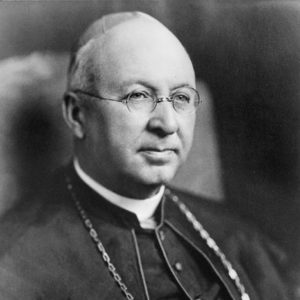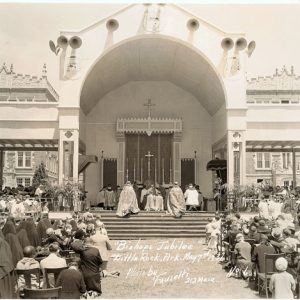calsfoundation@cals.org
John Baptist Morris (1866–1946)
John Baptist Morris was the third Roman Catholic bishop of the Diocese of Little Rock, which still corresponds to the political boundaries of Arkansas. Known as a gifted orator, Bishop Morris served for four decades as Arkansas’s Catholic leader while the diocese underwent tremendous institutional growth. This was accomplished as the U.S. went through two world wars and a massive economic depression.
John Baptist Morris was born on June 29, 1866, on farm near Hendersonville, Tennessee, the eldest son of John Morris and Anne Morrissey, both immigrants from Ireland. Morris received his first formal education at St. Mary’s College in Lebanon, Kentucky. It is not clear what degree Morris earned, for in 1887, he returned to live with his family, who had moved to Nashville, Tennessee. Shortly thereafter, he decided to enter the priesthood, and Bishop Joseph Rademacher of Nashville sent him to Rome for study. Ordained there on June 11, 1892, Morris returned to Nashville to serve at St. Mary’s Cathedral under a new bishop, Thomas S. Byrne. In 1894, already serving as the personal secretary to the Tennessee bishop, Morris became the cathedral’s rector the next year and then vicar general of the Diocese of Nashville by June of 1900. Six months later, Pope Leo XIII granted him the title of monsignor; six years later, Pope Pius X appointed him coadjutor bishop of Little Rock (Pulaski County), the first native Tennessean to be elevated to the American Catholic hierarchy. He was consecrated into the Catholic episcopacy for the Diocese of Little Rock in St. Mary’s Cathedral in Nashville on June 11, 1906, fourteen years to the day after his ordination.
As coadjutor bishop, Morris would become the full prelate upon the death of the aged and infirm Bishop Edward M. Fitzgerald. When Fitzgerald died on February 21, 1907, Morris immediately became the third Catholic bishop of Little Rock. As bishop through two world wars and the Great Depression, Morris also dealt with a resurgent anti-Catholicism during the first decade of his episcopacy, as exemplified by the Convent Inspection Act of 1915. Many Roman Catholics were of German descent, and many parishes along with Arkansas River west of Little Rock were still served by German-speaking priests; such Catholics found themselves under suspicion during World War I. Bishop Morris vocally supported the American war effort and engaged in selling of war bonds. The bishop’s strong patriotism, and his close personal friendship with a powerful Arkansas politician as Joseph T. Robinson, helped to mitigate much bigotry.
This short, stocky, bespectacled bishop oversaw a tremendous expansion of Catholic institutions. He founded St. Joseph’s Orphanage in 1909, which lasted in North Little Rock (Pulaski County) for more then sixty years. He established St. John’s Home Mission Seminary in Little Rock in 1911, and it lasted fifty-six years. In that same year, the Diocese of Little Rock began publishing a weekly Catholic newspaper, called The Southern Guardian (now known as the Arkansas Catholic). Some institutions, however, did not outlive his episcopacy. For example, he opened Little Rock College in 1908, Arkansas’s second Catholic institution of higher education, but it closed at the start of the Great Depression in 1930. (The first such institution, the College of St. Andrew, opened in 1849 but closed by the start of the Civil War.) During those difficult times, Morris opened a Black Catholic orphanage in Pine Bluff (Jefferson County), known as St. Raphael’s in 1932; it closed five years later.
Institutionally, the Catholicism grew during the four decades that Morris served as bishop. In 1906, there were sixty priests and two hundred sisters; by 1946, there were 154 priests and 582 women religious ministering in Arkansas. There were twenty-nine schools in 1906, but forty years later, there were eighty, and the number of students attending these schools had nearly tripled. By 1946, nine Black Catholic parishes were operating in the state, and seven had schools. While Catholic numbers did increase, Catholics in Arkansas were still only 1.7 percent of the overall population in 1940. The diocesan departments of education and social services had their origins during the Morris episcopacy.
Bishop Morris was quite an orator, a gift recognized nationally. He was one of the main speakers at a National Eucharistic Congress in New Orleans in 1935, and he gave a stirring address in Little Rock condemning anti-Semitism after the Nazi Kristallnacht attacks in Germany in November 1938. Due to his advancing age, Morris petitioned the Vatican in 1939 for an auxiliary bishop. The Vatican consented and named the man Morris recommended for the position, Vicar General Monsignor Albert L. Fletcher. On April 25, 1940, Fletcher became the first native Arkansan raised to a rank of the American Catholic hierarchy.
If day-to-day operations fell now to Auxiliary Bishop Fletcher, Morris still kept a close control over major appointments. It was Morris who named the new Monsignor James E. O’Connell as rector for the St. John’s Seminary in the fall of 1944. The Diocese of Little Rock marked its centennial on November 28, 1943, yet an aging and steadily incapacitated Morris could not really adequately celebrate the event. He did not live long after the end of World War II. He died in Little Rock on October 22, 1946, at the rectory at St. Andrew’s Cathedral and is buried in the crypt under the cathedral.
For additional information:
Archives of the Diocese of Little Rock. St. John’s Catholic Center, Little Rock, Arkansas.
Stritch, Thomas. The Catholic Church in Tennessee: A Sesquicentennial Story. Nashville, TN: The Catholic Center, 1987.
Woods, James M. Mission and Memory: A History of the Catholic Church in Arkansas. Little Rock: August House Publishing Company, 1993.
James M. Woods
Georgia Southern University
 Early Twentieth Century, 1901 through 1940
Early Twentieth Century, 1901 through 1940 Religion
Religion John Baptist Morris
John Baptist Morris  John Baptist Morris
John Baptist Morris  John Baptist Morris
John Baptist Morris 




Comments
No comments on this entry yet.